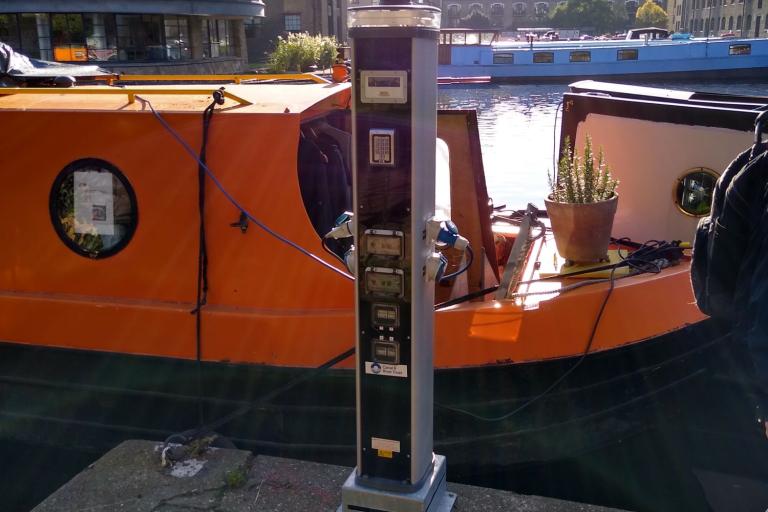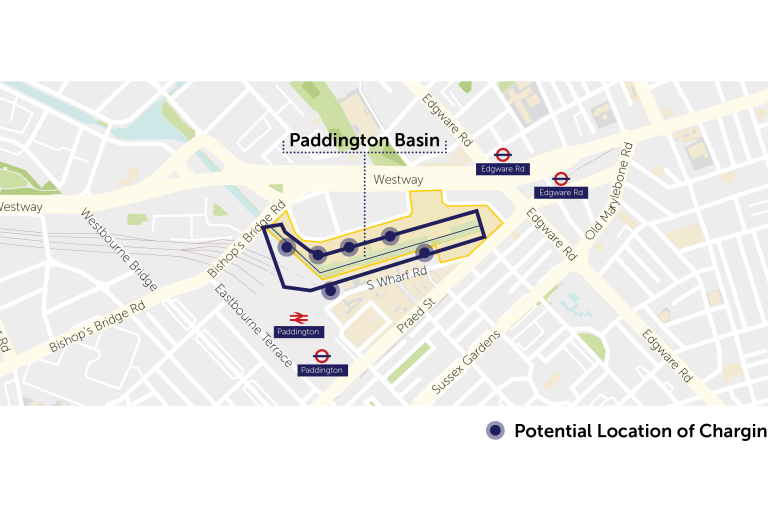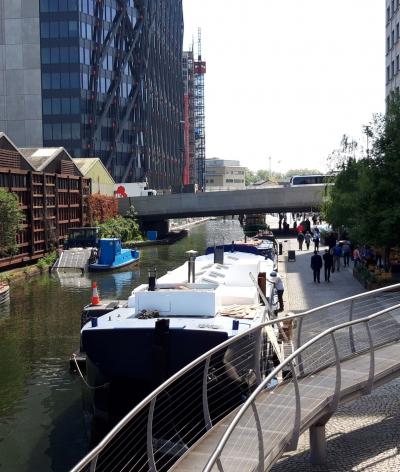We are working closely with the Canal and River Trust to identify opportunities to improve the air quality along the canal in Paddington Basin. We have undertaken a technical feasibility study into turning the Basin into an eco-mooring zone.
Where there is broad support for the project, funding opportunities to install such a zone in Paddington Basin will be investigated. This will include providing electricity points and seeking to reduce the current emissions from wood, coal burning and diesel generators at current moorings.
About the proposals

An eco-mooring zone is an area of canal that has additional measures in place to reduce pollution. The Paddington eco-mooring zone will provide up to 36 electrified moorings along the towpath from Merchant Square to the Basin.
Canal boats will be able to connect to the mains electricity and reduce wood and coal burning, running engines or generators for their on-board needs or for charging batteries. This will also enable heating and cooking to be provided by sources other than solid fuel stoves.
The Canal and River Trust and Islington Council are currently running a trial of a similar ‘eco-mooring’ zone for visiting boats between King’s Cross and Angel, either side of the Islington Tunnel on the Regent’s Canal.

- One point mooring location follows the canal east from where Bishop’s Bridge Road (A4206) crosses the canal along the south towpath.
- A pontoon in front of the building at 37 North Wharf Rd, known as The Point.
- One on the opposite side of the canal from the Point and situated along the south towpath.
- One positioned near the Paddington foot bridge.
- One positioned near Marks and Spencer’s head office.
- One on the opposite side of the canal from Mark’s and Spencer, situated along the south towpath.
Coal and wood burning impacts on both the environment and our health. Wood stoves and boilers, in general, have much higher emissions of many toxic pollutants compared to other heat sources.
One of the main pollutants emitted by burning solid fuels like wood is ultra-fine particulate matter (PM).
The health effects of particle air pollution have been widely studied and include premature death and the worsening of heart and lung disease. This often increases admissions to hospital, particularly in people who have an underlying respiratory condition.
According to the Department for Environment, Food and Rural Affairs (Defra), wood and coal fires are the single biggest source of particulate matter (PM2.5) pollution in the UK, even in London. Researchers at King’s College London found that wood burning was responsible for between 23% and 31% of all PM2.5 pollution.
The people most at risk from boat engine fumes are boaters themselves. Using cleaner sources of energy, like electric charging points, will benefit boaters’ health.
While living on the waterways can be a sustainable and environmentally friendly choice, in some busy areas the impact of engine noise and fumes can affect both waterside residents and other boaters. The eco-mooring zone would enable boaters to reduce their reliance on using their engines for energy and to embrace a greener way of life.

We understand that there may be additional costs for boat owners. We have undertaken some initial work through a feasibility study by a technical consultant, Arcadis Consulting (UK) Ltd, to help understand the potential costs of converting boats to rely on electricity when moored and they are detailed below.
This is a typical cost for an average-sized boat, of 57 foot or 17.4 metres in length. We understand that there may be financial pressures on our residents, and we are investigating whether there will be funding available to make these improvements.
- Wiring, £950
- Fixtures, £275
- Consumer unit, £120
- Electrical appliances, £100
- Total, £1445
St Mary’s Hospital have been impacted by emissions from the canal. Wards, and surgical theatre have had to be temporarily closed due to smoke and pollutants being drawn into their buildings from the canal basin. Given the current pressure on the NHS due to the pandemic and long waiting lists for key operations, it is important that we do as much as we can to reduce this impact.
Consultation update
Following from our summer engagement period, July to September 2022, we wanted to provide a summary of the feedback we have received and our next steps for the project.
Engagement
Our approach to community engagement has included:
- two pop up events along Paddington Basin to gather feedback from those in the area.
- three meetings with key stakeholders, NBTA, St Mary’s Hospital NHS and Merchant Square landowners.
- A social media campaign running from 19 August to 11 September 2022.
- Flyers were distributed to 4,362, addresses on 22 July 2022. The flyer was posted via Royal Mail and included information on how the local community could contact the project team and give their feedback on the campaign.
- Our consultation website for the project received 408 unique page views.
Feedback
Throughout the campaign, we received a wide variety of feedback from residents, businesses and canal boat owners and dwellers.
A total of 94 people completed an online form, and we received three additional emails from residents or groups.
The main issues are summarised below:
- Of the 94 people who responded to our online survey, 49% stated that they were in support of the electrification of the Paddington mooring sites
- 28% stated that they were not in support and 23% were unsure and needed more information
- Feedback was mixed from different groups. Residents and locals overall supported the initiative whilst some boat owners had reservations and wanted further detail.
Conclusion and next steps
We would like to thank everyone who has taken the time to provide us with feedback on the campaign. The feedback received in response to the proposals have been mixed and many people who responded wanted further information to understand how the eco-moorings would work in practice.
This included:
- whether funding is available for conversion of boats
- how they would be able to use the eco-moorings
- the cost of mooring and electricity in the area
- whether there is a possibility to use other methods of electricity such as wind, solar etc to make it even more sustainable
- the impact of wider pollutants in the area
Next steps
- The findings will be presented to political members to steer the decision-making process.
- Should the decision be made to take this further, funding mechanisms will be investigated to implement the concept, whilst taking all feedback on board.
- We will continue to update this website as the project progresses.

